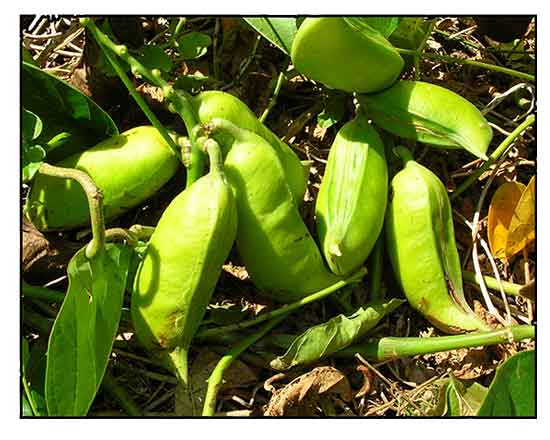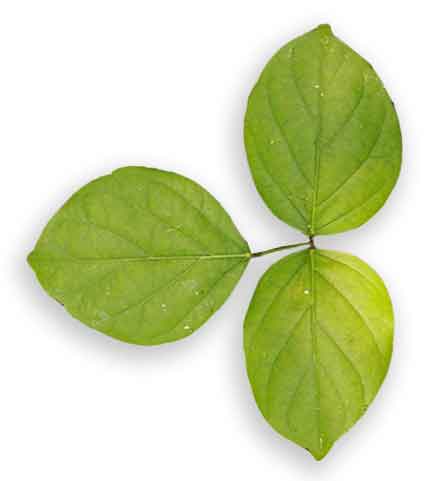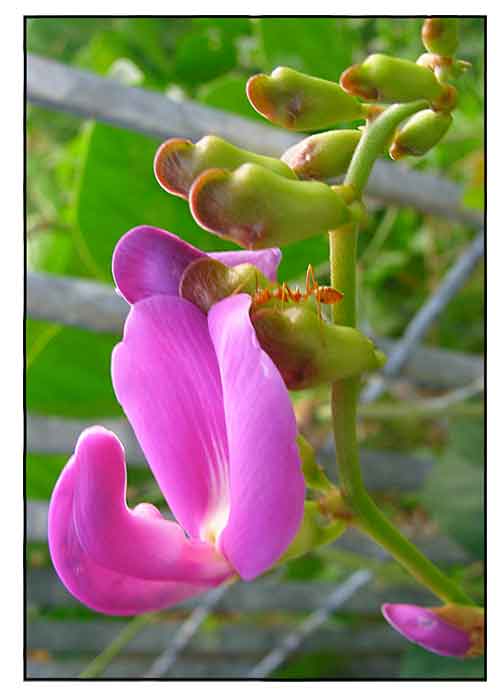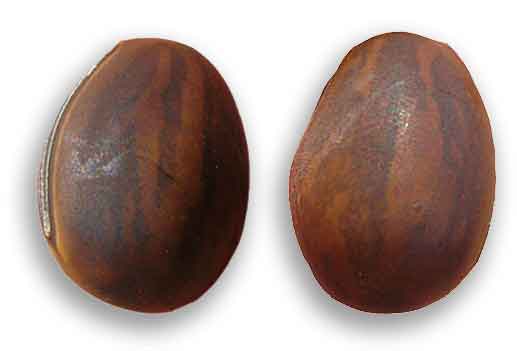Gen info
- Canavalia cathartica is a species of flowering plant in the legume family Fabaceae.
- Etymology: The genus name derives from kanavali, the Malabar name for this genus of climbing herbs, meaning "forest climber". The specific epithet cathartica means 'purgative'.
 Botany Botany
• Canavalia cathartica is a perennial climber, 3-10 m long. Stem sparsely pubescent or glabrous. Leaves trifoliolate; leaflets ovate or broadly elliptical to rounded, 3-20 cm × 2.5-13.5 cm, glabrous or sparsely pubescent. Inflorescence racemose, pendant, 4-12 cm long beyond a 10-22 cm long peduncle. Flowers scented; calyx tube 9-11 mm long, upper lip 3 mm long, pubescent, green speckled with crimson when fresh; standard 2.5-3.5 cm long, magenta to purple, paler outside, wings and keel paler with white base; stamens 10, monadelphous. Pod oblong, 8-12 cm × 3-4.5 cm, curved, sutures not parallel, slightly inflated, indehiscent or tardily dehiscent, with 2 ribs along sutures and additional rib just below suture, often quite hairy when young. Seed oblong-ellipsoid, 14-18 mm × 9-12 mm, slightly compressed. (2)
 • Canavalia cathartica is a biennial or perennial herb with thick, twining, climbing stems. Pinnate leaves are each divided into three papery leaflets which are generally oval in shape with pointed or rounded tips, up to 20 centimeters long by 14 wide, but usually smaller. Inflorescence is a raceme or pseudoraceme of several flowers. Flower has a bell-shaped calyx of sepals with two lips, an upper lip with two lobes and a lower lip with three teeth. Flower corolla is pink or purplish with a white-spotted standard petal and two wing and two keel petals each roughly 3 centimeters long. Fruit is an inflated, turgid legume pod up to 13.5 centimeters long by 4.5 wide. Fresh mature pod can weigh over 32 grams. Seeds are hard, smooth, reddish brown, darkening deeper brown, and reaching nearly 2 centimeters long by one wide. (3) • Canavalia cathartica is a biennial or perennial herb with thick, twining, climbing stems. Pinnate leaves are each divided into three papery leaflets which are generally oval in shape with pointed or rounded tips, up to 20 centimeters long by 14 wide, but usually smaller. Inflorescence is a raceme or pseudoraceme of several flowers. Flower has a bell-shaped calyx of sepals with two lips, an upper lip with two lobes and a lower lip with three teeth. Flower corolla is pink or purplish with a white-spotted standard petal and two wing and two keel petals each roughly 3 centimeters long. Fruit is an inflated, turgid legume pod up to 13.5 centimeters long by 4.5 wide. Fresh mature pod can weigh over 32 grams. Seeds are hard, smooth, reddish brown, darkening deeper brown, and reaching nearly 2 centimeters long by one wide. (3)
Distribution
- Native to the Philippines.
- Also native to Andaman Is., Bangladesh, Bismarck Archipelago, Borneo, Cambodia, Caroline Is., Chagos Archipelago, China Southeast, Christmas I., Cocos (Keeling) Is., Cook Is., Fiji, Hainan, India, Jawa, Kenya, KwaZulu-Natal, Laccadive Is., Lesser Sunda Is., Line Is., Malaya, Maldives, Maluku, Marianas, Marshall Is., Myanmar, Namibia, Nansei-shoto, Nauru, New Caledonia, New Guinea, Nicobar Is., Northern Provinces, Northern Territory,, Queensland, Samoa, Saudi Arabia, Seychelles, Society Is., Solomon Is., Somalia, South China Sea, Sri Lanka, Sulawesi, Sumatera, Swaziland, Taiwan, Tanzania, Thailand, Tonga, Tubuai Is., Tuvalu, Vanuatu, Vietnam, Yemen. (1)
 Constituents Constituents
- Quualitative analysis of methanol extract of leaves yielded phenols, tannins, flavonoids, glycosides, steroids, terpenoids, reducing sugars, with absence of alkaloids, saponins, and proteins. (5)
-
GC-MS analysis of methanol extract of leaves yielded 1,3-Dioxolane, 2,4,5-trimethyl-, Catecholborane, 2-Cyclohexen-1-one, 3 methyl- 6-(1-methylethylidene)-Diethyl Phthalate, Thiophene, 2-ethyltetrahydro-2-[2-(2-Ethoxyethoxy)ethoxy] Ethyl acetate, 2-[2-[2(2-Butoxyethoxy)ethoxy]ethoxy]ethyl acetate, Isophytol. Total phenol content was 84.93 µg/mg of GAE and flavonoid content was 18.50 µg/mg of QE. (5)
- Proximate composition screening of seeds yielded crude proteins 31.2%, crude lipid 1.86%, crude carbohydrates 61.4%, and calories1580kJ. Crude protein content was higher than common cereals, whole-wheat flour (8.55%), parboilded rice (7.7%), and egg (12.6%).
(see study below) (6)
- Proximate composition of tender pod
on dry weight basis (g/100g) of raw and cooked pods: Moisture 10.89 and 5.06%; crude protein 23.28 and 13.98, crude lipid 2.26 and 1.08, crude fiber 15.34 and 11.14, ash 4.88 and 3.98, crude carbohydrates 54.24 and 69.82, energy 1383 and 1444 kJ/100g, vitamin C 0.442 and 0.3, respectively. (9)
- Mineral composition of tender pods on dry weight basis (mg/100 g) raw and cooked: Na 48.17 and 36.76, K 102.18 and 83.25, Ca 382.26 and 246.25, P 78.96 and 53.99, Mg 108.75 and 94.83, Fe 0.84 and 0.041, Cu 0.19 and 0.049, Zn 11.93 and 5.16, Mn 10.82 and 7.95, Se 12.91 and 12.63, respectively. (9)
 Properties Properties
- Toxicity: Mature fruits are reportedly poisonous. Seeds reportedly edible when detoxified by cooking or boiling. (10) (Note: Search has not yielded information or studies relating to cathartic or purging effect.)
-
Contains antinutrients (phenols, tannins, and lectins) and requires some processing or preparation before use as food. Pressure cooking can reduce the antinutrients; roasting, too, although less effectively. (3)
- Studies have suggested antioxidant, anticancer, nutritive, toxic properties.
Parts used
Leaves, roots, bark, beans.
Uses
Edibility
- Fruit are edible. Boiled fruits used as snacks.
- Seeds and pods used as famine food in coastal India.
- Raw seeds reportedly toxic.
Folkloric
- No reported folkloric medicinal use in the Philippines.
-
Irula tribes apply crushed leaves on skin to treat ringworm.
- In Micronesia, used as herbal remedy for cough.
- Seeds reported to stimulate sleep. Leaves, roots, and seeds used for cuts, purifying blood, worms, skin diseases. Leaf extract used for fever. Roots and bark used for killing intestinal worms. (10)
Others
- Fiber: Broad, white fibers from stems used for making carrying nets. (2)
- Erosion control: In India, the plant grows in mangroves. Seeds float on water and land on coastal sand dunes, where it establishes, forming mats, binding the sand, helping prevent erosion. (3)
- Green manure: In small-scale agriculture, farmers use the plant as green manure and mulch, hosting it in fields for nitrogen fixation. (3)
Studies
• Antioxidant / Leaves: Study evaluated a methanol extract of leaves for antioxidant activity. Radical scavenging activity of methanol extract of leaves by DPPH assay at concentration 20, 60, 100, and 120 µg/ml showed %RSA of 18.57, 36.38, 54.19, and 65.23%, respectively. Total phenol content was 84.93 µg/mg of GAE and flavonoid content was 18.50 µg/mg of QE. (see constituents above) (5)
• Antioxidant / Leaves: Study evaluated different tissues (tender pods, ripened beans, ungerminated and germinated seeds, tender and senescent leaves) of Canavalia cathartica and C. maritima for L-canavanine (Lc) and L-arginine (La). Raw seeds and raw ripened beans possessed the highest quantity of L-canavanine in C. cathartica and C. maritima, respectively. Cooking significantly reduced Lc in raw and germinated seeds and cooked tender pods. Tender leaves of LC possess considerable amount of Lc and La. Biomass of tender leaves can be a potential source of commercially exploitable therapeutically, pharmaceutically, and nutraceutically valuable La and Lc. (6)
• Nutritional Composition and Biological Evaluation: Proximate composition screening of seeds yielded crude proteins 31.2%, crude lipid 1.86%, crude carbohydrates 61.4%, and calories1580kJ. Crude protein content was higher than common cereals, whole-wheat flour (8.55%), parboiled rice (7.7%), and egg (12.6%).
Seeds possessed 1420 mg/100g total phenolics and strong hemagglutination activity, while tannins and trypsin inhibition activity were absent. The protein efficiency ratio, food efficiency ratio, net protein retention, protein retention efficiency, biological value, net protein utilization and true digestibility of C. cathartica seeds were significantly different (P < 0.05) from casein. In spite of the high protein content, animal-feeding trials indicated low nutritional quality. (7)
• Invitro Cytotoxicity / Cancer Cell Lines MCF7 and HT29 / Beans: Study evaluated the cytotoxicity of methanol extract of raw, cooked, and solid-substrate fermented (Rhizopus oligosporus) split beans of wild legumes (Canavalia cathartica and C. maritima) on cancer cell lines MCF7 and HT29. Methanol extract of cooked (C. maritima) and fermented (C. cathartica) split beans showed better invitro anticancer activities compared to raw beans. Results suggest the active principles of ME of cooked and fermented Canavalia beans have potential to inhibit cancer cell lines MCF7 and HT29. Extract of cooked and fermented beans may be part colon cancer diet management. (8)
Availability
Wild-crafted. |

![]()






 Properties
Properties